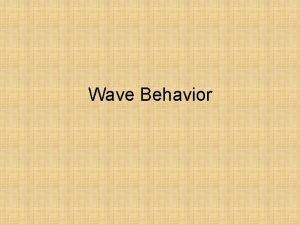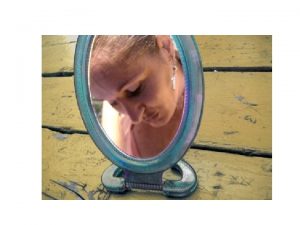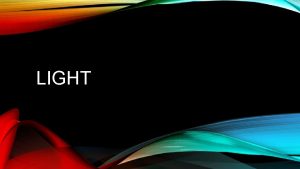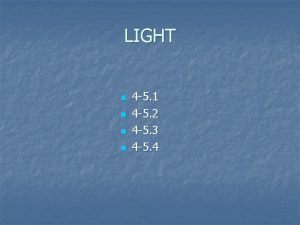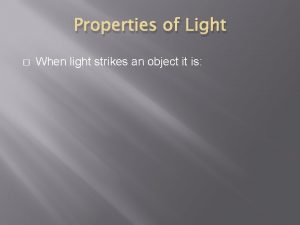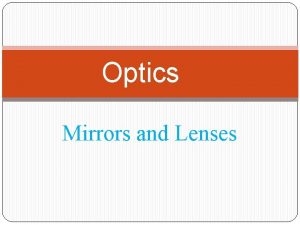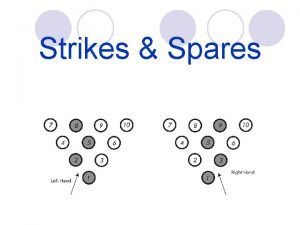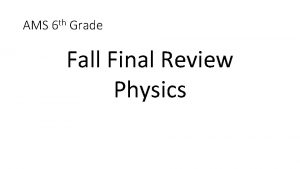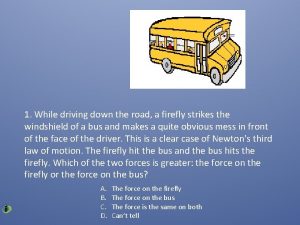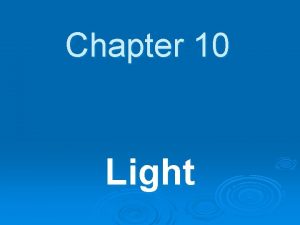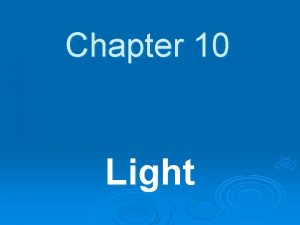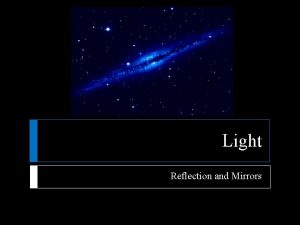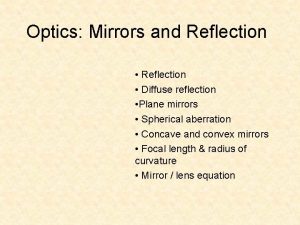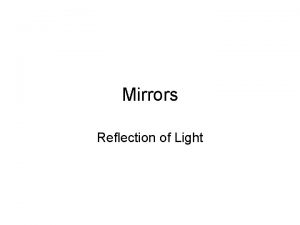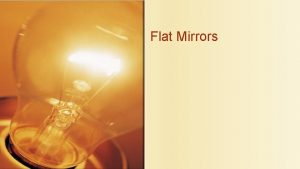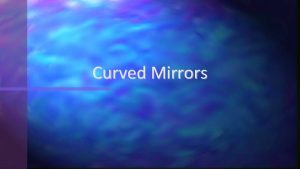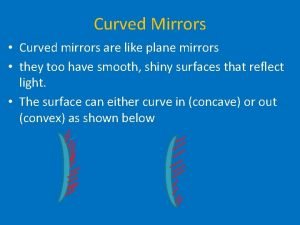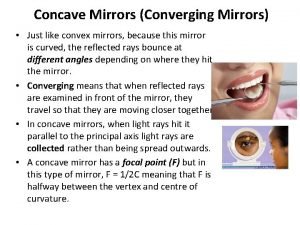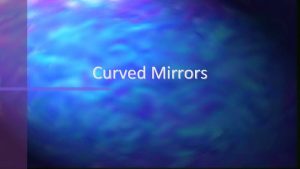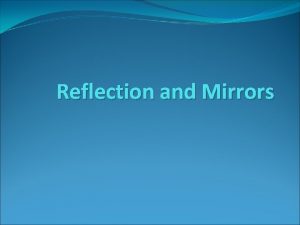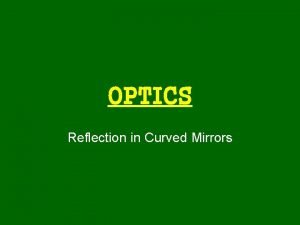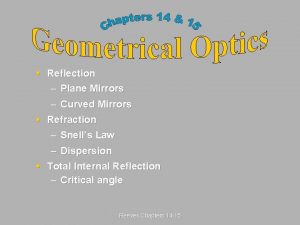Chapter 10 Light Reflection Mirrors When light strikes

















- Slides: 17

Chapter 10 Light

Reflection & Mirrors When light strikes an object Ø It is either reflected, absorbed or transmitted. Ø l l l Opaque: a material that reflects or absorbs the light – can’t see through it. -wood Transparent: The material transmits light – allows light to pass through it– glass Translucent: allows some light to pass through – can’t see image clearly – wax paper, frosted glass.

Kinds of Reflections Ø Ø You see objects because light is reflected, bounced off of it. Law of Reflection: Angle of incidence equals the angle of reflection – l Ø Ø Angle coming in = angle going off Regular Reflection: reflection off smooth surface – a mirror Diffuse Reflection: Irregular or bumpy, uneven surface – wall

Real or Virtual? Image: a copy of an object formed by reflected or refracted light Virtual image: right side up appears to be coming from behind the mirror. Ø Real Image: is formed when reflected light rays actually meet at a point. The image is upside down (inverted), Ø Ø

3 Types of Mirrors Ø Ø Plane Mirror: a flat mirror – produces an image that is right side (virtual) up and the same size as the original object – Concave Mirror: a mirror with a surface curved inward like a “cave” or a bowl. l l Ø Light reflected comes together to meet at a Focal Point. Can produce virtual or real images Convex Mirrors: l l l A mirror w/ a curved surface facing outward Reflected rays appear to come from a focal point behind the mirror Images formed are always Virtual Concave mirror Plane mirror Convex mirror

Refraction of Light: Bend or change direction Ø 1. As light rays enter a new medium the cause light to bend Ø 2. The denser the medium – the slower the light travels Ø 3. Index of Refraction: Refraction a measure of how much a medium bends the light that travels through it. Ø

Prisms & Rainbows Ø Prisms: Prisms Separates white light into its component colors. l Ø The longer the wavelength, the less it will be bent by the prism. Rainbows light shining thru tiny droplets of water, each droplet acts as a prism

Lens – Concave & Convex Ø Lenses – a curved piece of material used to bend light l Concave lenses: lenses as light passes through, they are bent away from the center Convex Lens • Images produced are only virtual, not real l Convex lenses: lenses cause light passing through to bend toward the focal point. • The images produced depends on the position of the object Concave Lens

Color Ø The color of the object you see is the light that is reflected from its surface. All other colors are absorbed by the object.

Primary & Secondary Light Colors Ø Ø Ø The 3 colors of light that can combine to form all other colors are colors – a. Red, Blue, Green i. Equal Red + Equal Blue = Magenta (secondary color) ii. Equal Red + Equal Green = Yellow (secondary color) iii. Equal Green + Equal Blue = Cyan (secondary color) iv. Equal Red + Equal Green + Equal Blue = White Magenta Yellow Cyan primary

Primary + Secondary = White Ø Ø Ø Any 2 colors that combine to form white are complementary colors Secondary color + remaining Primary Color = White Magenta + Green = White Cyan + Red = White Yellow + Blue = White Magenta Yellow Cyan

Pigments Ø Ø Ø Ø Pigment – substance that color other materials like paints, inks, etc a. Primary Pigments are Cyan, Yellow & Magenta b. Cyan + Yellow + Magenta = Black c. Cyan + Yellow = Red d. Yellow + Magenta = Red e. Cyan + Magenta = Blue f. The primary pigments are the secondary light colors! Blue Red Green

Compare Lights & Pigments Three primary colors = three secondary pigments Ø Three primary pigments = Three secondary colors Ø

Vision - Structure Need to know these structures & their function: Ø Cornea: begins to focus light Ø Ø Aqueous humor: fluid between inside of cornea & the outside of the lens Iris: the color of the eye. A muscle that opens & closes to regulate pupil size Pupil: hole through which light passes Lens: flexible structure that focuses image on the retina

Vision - Structure Need to know these structures & their function: Ø Ciliary muscle: ligaments Ø Ø Ø attach the lens to these, they contract & stretch the lens allowing near & far focus Vitreous humor: fluid inside eyeball maintains size & shape of the eye Retina: contains the rods & cones that are sensitive to light Choroid coat: middle layer of the eyeball Sclera: the outer “whites of the eye” Optic nerve: takes rod & cone impulse back to the occipital lobe for processing

Image Processing Fovea – The central region where images focused is the fovea. Ø Rods – about 1 billion, sensitive to brightness, light and dark & movement Ø Cones – detect color, about 3 million. 3 types of cones, sensitive to red, blue & green wavelengths of light. Ø All rods & cones have nerve fiber attached, these collect at the back of the eye and form the optic nerve which carries the signal back to the eye. Ø

That’s All for Chapter 10!! CYA Later
 Chapter 17 reflection and mirrors
Chapter 17 reflection and mirrors Reflection is when a wave strikes an object and
Reflection is when a wave strikes an object and Reflection and mirrors ppt
Reflection and mirrors ppt Different properties of light
Different properties of light Light behaves differently as it strikes different objects
Light behaves differently as it strikes different objects When light strikes
When light strikes Light reflection color
Light reflection color Light light light chapter 23
Light light light chapter 23 Light light light chapter 22
Light light light chapter 22 Chapter 22
Chapter 22 Chapter 16 section 2 japan strikes in the pacific
Chapter 16 section 2 japan strikes in the pacific Diffuse reflection vs regular reflection
Diffuse reflection vs regular reflection Strikes unions and collective bargaining
Strikes unions and collective bargaining Strikes and spares
Strikes and spares Which of these expresses a vector quantity
Which of these expresses a vector quantity Miners strike 1912
Miners strike 1912 A car traveling at 100 km/h strikes an unfortunate bug
A car traveling at 100 km/h strikes an unfortunate bug While driving down the road a firefly
While driving down the road a firefly

